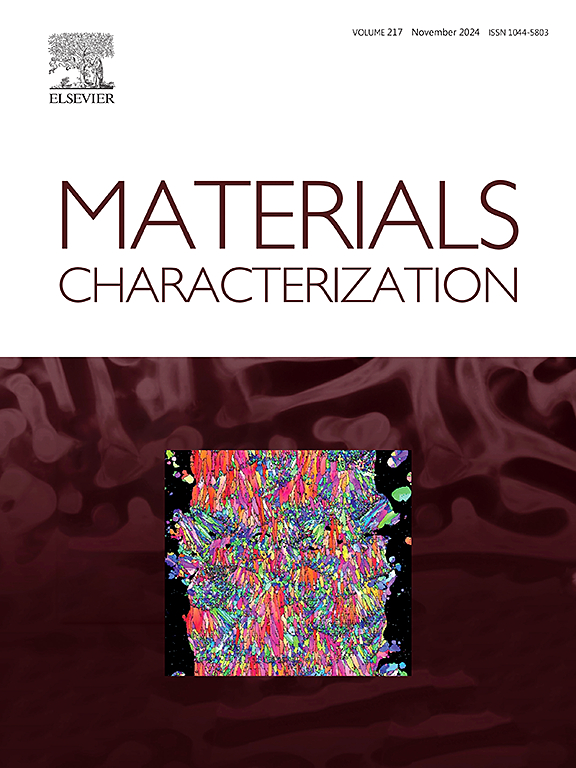Suction casting-cooling gradient mediated grain orientation in Fe2NiCoCr(VN)0.5 high-entropy alloys for strength-plasticity synergy
IF 5.5
2区 材料科学
Q1 MATERIALS SCIENCE, CHARACTERIZATION & TESTING
引用次数: 0
Abstract
This study investigates the effects of suction casting parameters on the microstructure and mechanical properties of Fe2NiCoCr(VN)0.5 high-entropy alloys (HEAs). By adjusting copper mold diameters (7 mm, 6 mm, 5 mm, and 4 mm), gradient cooling rates were established, linking solidification induced microstructural evolution to mechanical performance. Reducing the mold diameter (and thus increasing the cooling rate) enhances the degree of grain preferred orientation. The 5 mm sample exhibits a dual microstructure: columnar grains with [001] and [101] crystallographic orientations coexisting with equiaxed grains. Transmission electron microscopy characterization of the 5 mm alloy reveals a metastable dislocation network near the fracture zone, contributing to exceptional strength-plasticity synergy with a yield strength of 416 MPa, ultimate tensile strength of 950 MPa, and elongation of 62 %. Compared to the 7 mm alloy, the 5 mm alloy shows increases of 42.9 % in yield strength, 52 % in ultimate tensile strength, and 44.2 % in elongation. Molecular dynamics simulations demonstrate that equiaxed and columnar grains jointly govern dislocation slip behavior through multi-slip activation, enhanced dislocation storage, and regulated grain interactions. This mechanism achieves a balance between homogeneous plastic deformation and localized stress distribution. The work elucidates the role of cooling rate in microstructural evolution and establishes a framework for optimizing HEA performance through solidification parameter control.

Fe2NiCoCr(VN)0.5高熵合金吸铸冷却梯度介导晶粒取向的强度塑性协同效应
研究了吸力铸造工艺参数对Fe2NiCoCr(VN)0.5高熵合金(HEAs)显微组织和力学性能的影响。通过调整铜模直径(7mm, 6mm, 5mm和4mm),建立了梯度冷却速率,将凝固诱导的微观组织演变与机械性能联系起来。减小模具直径(从而提高冷却速度)可以提高晶粒择优取向的程度。5mm试样呈现出双重微观结构:具有[001]和[101]取向的柱状晶粒与等轴晶粒共存。透射电镜表征表明,5mm合金在断口附近存在亚稳位错网络,具有优异的强度-塑性协同作用,屈服强度为416 MPa,极限抗拉强度为950 MPa,延伸率为62%。与7mm合金相比,5mm合金的屈服强度提高42.9%,极限抗拉强度提高52%,伸长率提高44.2%。分子动力学模拟表明,等轴晶和柱状晶通过多滑移激活、强化位错储存和调节晶粒相互作用共同控制位错滑移行为。该机制实现了均匀塑性变形和局部应力分布之间的平衡。研究阐明了冷却速率在微观组织演变中的作用,并建立了通过凝固参数控制优化HEA性能的框架。
本文章由计算机程序翻译,如有差异,请以英文原文为准。
求助全文
约1分钟内获得全文
求助全文
来源期刊

Materials Characterization
工程技术-材料科学:表征与测试
CiteScore
7.60
自引率
8.50%
发文量
746
审稿时长
36 days
期刊介绍:
Materials Characterization features original articles and state-of-the-art reviews on theoretical and practical aspects of the structure and behaviour of materials.
The Journal focuses on all characterization techniques, including all forms of microscopy (light, electron, acoustic, etc.,) and analysis (especially microanalysis and surface analytical techniques). Developments in both this wide range of techniques and their application to the quantification of the microstructure of materials are essential facets of the Journal.
The Journal provides the Materials Scientist/Engineer with up-to-date information on many types of materials with an underlying theme of explaining the behavior of materials using novel approaches. Materials covered by the journal include:
Metals & Alloys
Ceramics
Nanomaterials
Biomedical materials
Optical materials
Composites
Natural Materials.
 求助内容:
求助内容: 应助结果提醒方式:
应助结果提醒方式:


